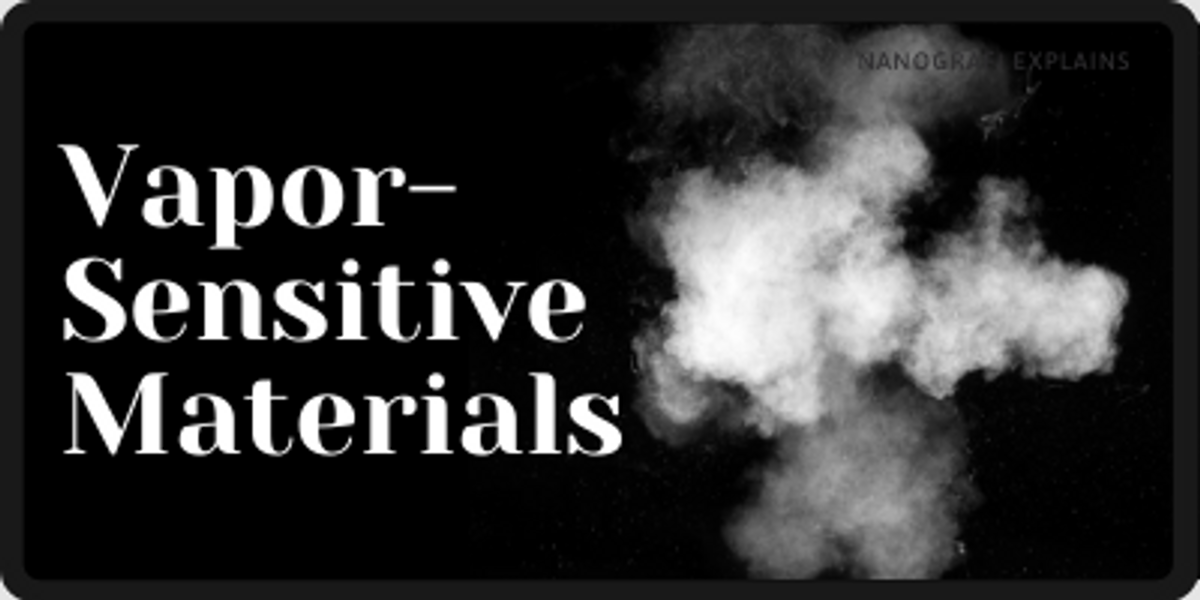Vapor-Sensitive Materials
Polysaccharides are the long-chain carbohydrates with a significant role in nature and biological systems such as water retention and molecular recognition.
The structures of polysaccharides in their microscale are hardly ever applied in vitro due to the challenges with regulating the self-assembly.
Vahid Javan Kouzegaran
Analytical Chemist (Ph.D.) / Nanografi Nano Technology
Introduction
It's been demonstrated that cyanobacterial polysaccharides known to be sacran, are capable of self-assembling to serve as twisted fibers to move from nanoscale to microscales with the diameter of 1 µm and the length smaller than 800 µm being remarkably larger than previously reported polysaccharide. Compared to rigid fibrillary polysaccharides, the sacran fiber is flexible enough to transform into two-dimensional snaking (2D) of three-dimensional (3D) twisted structures at the interfaces where water is present as vapor. Recently, a vapor sensitive film with a milliseconds-scale response has been developed from the cross-linked polymer based on its spring-like nature of the three-dimensional twisted structure. Polysaccharides are categorized as natural products with a lot of importance owing to their qualification for medical applications, compatibility in the environment, biocompatibility with the products that are available commercially such cosmetics and foods 1.
Vapor-Sensitive Sacran
Within the past years, many different types of the advanced soft materials have been fabricated based on the use of polysaccharide-based nano architectures including cellulose nanofibers quit applications in engineering flexible paper device and pullulan used broadly in drug delivery Systems. Furthermore a variety of architectures of self-assembled polysaccharides in the Rangers like nano submicron house showing huge potentials in the field of Material Science because of their biomedical polymerization originating from different arrays and saccharides. Nevertheless, the basic hierarchical polysaccharide structures aren't used more commonly do you two problems in regulating their self-assembled in macron scales. On the contrary various types of materials inspired by the biological systems have been synthesized taking care of advantage of synthetic polymers like soft actuators that are sensitive to environmental changes including humidity charge on temperature 2.
The responsive capability of these materials is intensified through immobilizing functional nanoparticles or molecules in the polymer networks. Regarding the origin of polysaccharides and where they originated from, polymers are supposed to possess considerable potential to be applied in not only in aqueous solutions, but also where there are moisture and environments with a lot of humidity. Once the self-assembly based on these natural polysaccharides could be reconstructed in vitro, there will be a possibility to have a deeper understanding of morphological changes concerning the self-assembly in water along with advances in developing a new class of bio-inspired materials with the ability to regulate structures in nanoscale.
Sacran is defined as a natural polysaccharide obtained during an extraction process from cyanobacteria Aphanothece sacrum of the freshwater. It is a special type of polysaccharides that has turned out to possess unique properties including the composition of as many as 10 types of sugars and the weight in megamolecular scale of about 106 to 108 gram per mole. Similar to other polysaccharides, sacran contains strong rod bundles with a helical structure at the molecular level. When it is extracted from the freshwater, sacran exhibits a crystallinity as a stable polymeric liquid with practically low concentrations of >0.5 wt%. Sacran is able to self-assemble into huge fibers as big as one 1 µm and the length of about 200 µm. Remarkably, a cyanobacterium that has a diameter of 5 µm is capable of generating a large fiber of polysaccharide with an extracellular matrix. The transformations, microscopic nature and morphologies and microstructures of the fiber have been unidentified despite its unique polymeric properties 1.
To get more information about carbon nanotubes,
you can read our blog post here.
Vapor-Sensitive Materials Based on Nobel Metal Nanoparticles
Nanoparticles of noble metals have been studied broadly in many areas of science and technology particularly in gas sensors. In this application, nanoparticles are utilized based-on active layers to serve as modifiers in order to increase the parameters such as stability, sensitivity and selectivity. Even though it is very common to modify and impregnate semiconducting oxide layers using catalytic reactive, noble metal salts and nanoparticles are still attracting attention to be employed to modify organic active layers most commonly in the case of conducting polymers that are used as chemiresistors. There is enough proof that intrinsically insulating fluoropolymer films could be modified using nanoparticles to serve as vapor sensing films. These materials that are similar to Teflon materials are finely deposited using ion-beam sputtering technique to provide a reliable way to adjust films thickness as well as polymers structural properties including the average length as well as the linear chains of the cross-linking. Referring to metal nanoparticles inclusion, the use of apparatus equipped with a dual ion-beam makes it possible to control the dispersing polymer’s structure separately along with the nanoparticle size on the metal loading. These materials of composite nature could be grown with proper adhesion on a variety of substrates and that their thickness could be adjusted to be a few nanometers without leaving a considerable impact on the film compactness and homogeneity. Films as metal–CFx (Me–CFx) have found a lot of applications in technology and in many areas of industries such as electronics as well as scientific applications like analytical chemistry and medicine. Nanostructured films of Metal–CFx are utilized as active layers sensing devices for sensing organic vapors. It has been demonstrated that Pd- Au-modified Cfx layers bear swelling processes upon exposure to analyte molecules being responsible to modify many physical and chemical properties leading to vapor detection through using a range of sensing transduction mechanism 3.
Vapor-Sensitive Materials Based on Carbon Nanotubes
A chemical with the quality of vapor sensing has been fabricated using multi-walled carbon nanotubes/hydrocele hydroxyl propyl methyl cellulose/cellulose composite films prepared at room temperature. When the film is placed in a polar organic solvent such as methanol and ethanol, a negative vapor coefficient is observed where the sensitivity of the film to vapors increases so considerably as the temperature rises. It is interesting that the resistance of the films also increases in a linear fashion as the vacuum condition decreases. Additionally, satisfactory repeatability is achieved once there are changes in the resistance according to the alteration of vacuum condition. Carbon nanotubes possess unique mechanical, electronic and thermal properties. Regarding these properties, carbon nanotube/polymer composites preparation has been investigated because of the possible improvement in electrical characteristics of polymers when carbon nanotubes are distributed homogeneously in their matrix. Composite out of carbon nanotubes serve as a conducting means and disperse or aggregate according to changes in cellulose. Therefore, these composites could become sensitive to the media in their surroundings including temperature, humidity and more importantly vapors.
Conclusion
There have been efforts to develop devices to detect chemical agents in different phases, especially in gases phase in the last decade. There are technologies now to present advantages of a fast response to vapors with desirable sensitivity and selectivity with an interesting potential of being miniaturized as well. Polysaccharides (Sacran), carbon nanotubes and noble metal nanoparticles have shown potential capability in detecting vapors.
To get more information, you can visit Blografi.
References
1. Budpud, K., Okeyoshi, K., Okajima, M. K. & Kaneko, T. Vapor-Sensitive Materials from Polysaccharide Fibers with Self-Assembling Twisted Microstructures. Small 2001993, 1–7 (2020).
2. Matsumoto, K., Sakikawa, N. & Miyata, T. Thermo-responsive gels that absorb moisture and ooze water. Nat. Commun. 9, 1–7 (2018).
3. Cioffi, N. et al. The swelling of vapor-sensitive fluoropolymers modified with metal nanoparticles: Interpretation of the material-vapor interaction mechanism. Sensors Actuators, B Chem. 100, 9–16 (2004).
Recent Posts
-
Advanced Materials for Unmanned Aerial Vehicle (UAV) Protection Against Laser
Consider a UAV on a critical mission, rendered inoperative by a sudden laser attack. With the increa …26th Jul 2024 -
Simulation and Modeling of Material Properties
Our world is composed of a dazzling array of materials, each with its own unique properties that dic …19th Jul 2024 -
Advanced Coatings for Superior Corrosion and Wear Resistance
Corrosion and wear pose significant challenges across various industries, leading to substantial eco …12th Jul 2024







